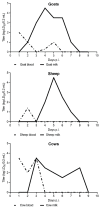Alimentary Infections by Tick-Borne Encephalitis Virus
- PMID: 35062261
- PMCID: PMC8779402
- DOI: 10.3390/v14010056
Alimentary Infections by Tick-Borne Encephalitis Virus
Abstract
Tick-borne encephalitis virus (TBEV) causes serious the neurological disease, tick-borne encephalitis (TBE). TBEV can be transmitted to humans by ticks as well as by the alimentary route, which is mediated through the consumption of raw milk products from infected ruminants such as sheep, goats, and cows. The alimentary route of TBEV was recognized in the early 1950s and many important experimental studies were performed shortly thereafter. Nowadays, alimentary TBEV infections are recognized as a relevant factor contributing to the overall increase in TBE incidences in Europe. This review aims to summarize the history and current extent of alimentary TBEV infections across Europe, to analyze experimental data on virus secretion in milk, and to review possible alimentary infection preventive measures.
Keywords: TBEV; alimentary infection; cows; goats; milk; sheep; tick-borne encephalitis virus.
Conflict of interest statement
The authors declare no conflict of interest.
Figures



References
-
- Wengler G., Bradley D.W., Collett M.S., Heinz F.X., Schlesinger R.W., Strauss J.H., Murphy F.A., Fauquet C.M., Bishop D.H.L., Ghabrial S.A. Virus Taxonomy Sixth Report of the International Committee on Taxonomy of Viruses. Fam. Flaviviridae. 1995;415:427.
Publication types
MeSH terms
Substances
LinkOut - more resources
Full Text Sources

